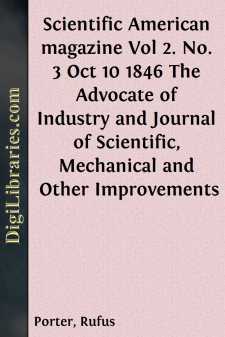Categories
- Antiques & Collectibles 13
- Architecture 36
- Art 48
- Bibles 22
- Biography & Autobiography 813
- Body, Mind & Spirit 142
- Business & Economics 28
- Children's Books 17
- Children's Fiction 14
- Computers 4
- Cooking 94
- Crafts & Hobbies 4
- Drama 346
- Education 46
- Family & Relationships 57
- Fiction 11829
- Games 19
- Gardening 17
- Health & Fitness 34
- History 1377
- House & Home 1
- Humor 147
- Juvenile Fiction 1873
- Juvenile Nonfiction 202
- Language Arts & Disciplines 88
- Law 16
- Literary Collections 686
- Literary Criticism 179
- Mathematics 13
- Medical 41
- Music 40
- Nature 179
- Non-Classifiable 1768
- Performing Arts 7
- Periodicals 1453
- Philosophy 64
- Photography 2
- Poetry 896
- Political Science 203
- Psychology 42
- Reference 154
- Religion 513
- Science 126
- Self-Help 84
- Social Science 81
- Sports & Recreation 34
- Study Aids 3
- Technology & Engineering 59
- Transportation 23
- Travel 463
- True Crime 29
Scientific American magazine, Vol. 2 Issue 1 The advocate of Industry and Journal of Scientific, Mechanical and Other Improvements
by: Rufus Porter
Categories:
Description:
Excerpt
The Viol Seraphine.
Introduction.--The clear tones of a viol or bass viol are generally admitted to be more melodious than those produced by other kinds of instruments, and many have expressed a desire to see an instrument so constructed as to be played with keys, like the organ or piano forte, and give the tones of the violin. This is the character of the instrument here introduced. It is elegant in appearance; occupies less than half the space of a piano forte, and is so light and portable that a lady-performer may readily place it before her, and thus avoid the necessity,--unpleasant to all parties,--of turning her back on the company. We do not say that an instrument of this kind has been as yet constructed complete: but the principle has been proved, and it may, and probably will be soon, offered to the public, at a cost not exceeding sixty dollars.
Explanation.--In the engraving, a side view elevation only is represented, showing only one string and one key of a series of twenty or more of each. The body of the machine A B, is a light hollow chest about three feet square and six inches deep, supported by four posts or legs with castors. Two bridges, C and D, extend across the breadth of the chest. The bridge D is supported by a cleat, E, in which is inserted the pin F, to which is attached one end of the string C D F. The other end of the string is simply attached to the bridge C. A key-lever, G H, passes through the bridge, and is mounted on a pivot therein. The front end of the key (G) is held in its ordinary position by a small spring thereunder, and may be easily depressed by the finger of the performer: the other end of the key serves as the bearing of the pivot of a delicate arbor, the opposite pivot of which has its bearing in the bridge D. On the front end of this arbor is a wheel three-fourths of an inch in diameter, with its periphery smooth, and polished with rosin, or rosin varnish; and so adjusted, that by the depression of the key, this wheel is brought up in contact with the string, whereby, if in motion rotarily, a full sound is produced, as if a violin bow was drawn across the string. On the other end of the arbor is a grooved pulley, over which passes a silken cord, which also passes round a delicate band-wheel, I, below, and by which, motion is communicated to the arbor and sounding wheel. The band-wheel is mounted on a shaft, I J, which has its bearings in two small head blocks which project from two crossbars: and from the block J is suspended a vertical rod, to the bottom of which is attached a treadle, K L, and from which a curved ratch, L M, extends upward and takes to a small ratchet on the shaft I J; so that, by the horizontal motion of the treadle, the motion is communicated to the wheel, &c. The teeth of the ratch and ratchet have so gentle an inclination on one side of each, that although the ratch applies force to the ratchet in the upward direction, they slide freely over in their return. It may be understood that the machine is to have two treadles and two ratches, which move forward alternately: and that twenty or more arbors, pulleys, strings and keys are arranged in series, although only one of each is represented in the engraving. The cord applies to each pulley in the series, by passing over the first, under the second, and over the third, and so on, descending from the last of the series to the band-wheel. Each arbor is placed directly under its respective string, and it is also proposed to place moveable stops under the strings, at equal distances from the key bridge, and to regulate the tones by adjusting the stops, without depending on the pins at the ends for that purpose. We shall employ a competent mechanic to construct one or more of these instruments as soon as convenient, and give due notice accordingly.
Casting my eyes over the bright, full moon, I perceived that an eclipse was just coming upon it. What astronomer had calculated this eclipse for Arabia? It was indeed a privilege to witness one in the bright sky that over-spread the lonely mountains of Seir. Soon we were seated in a circle, with our Arabs round their watch-fire, enquiring of them their views of an eclipse, and explaining to them ours. They appeared to have no idea of its real cause, regarding it as a judgment from God, a sign of a bad season, and little camel feed. When we undertook to explain to them the theory of the earth being round, turning over every day, sometimes getting between the sun and moon, they seemed to look upon us as telling very strange tales. The eclipse was nearly total. I gazed upon it with interest, and then eyed the strange scene around me. The wild, lonely landscape of rock and sand--the camels kneeling round the bivouac--the wild faces of the Arabs, reflecting the red light of the fire round which they were seated--their wild voices and strange guttural language, all combined to produce an effect so startling, that I felt till then I had never been thoroughly sensible of our complete separation from the civilized world.
Giving Credit.
"One of our exchange" says one of our exchanges, "came to us this week with four of our editorials not credited." A frivolous complaint. Not a week passes but we find in some of our exchanges from ten to twenty of our editorials; and instead of complaining, we are thankful for being thus complimented.
This instrument was devised by Col. James Bowie, an American, and a man of desperate valor. He considered, and apparently with justice, too, that, in close fighting, a much shorter weapon than the sword ordinarily in use, but still heavy enough to give it sufficient force, and, at the same time, contrive to cut and thrust, would be far preferable, and more advantageous to the wearer. He accordingly invented the short sword, or knife, which has since gone under his name. It is made of various sizes; but the best, I may say, is about the length of a carving knife--case perfectly straight in the first instance, but greatly rounded at the end on the edge side; the upper edge at the end, for the length of about two inches, is ground into the small segment of a circle and rendered sharp; thus leaving an apparent curve of the knife, although in reality the upturned point is not higher than the line of the back. The back itself gradually increases in weight of metal as it approaches the hilt, on which a small guard is placed. The Bowie knife, therefore, has a curved, keen point; is double edged for the space of about a couple of inches of its length; and when in use, falls with the weight of a bill hook.--Bowie went to Texas during the troubles which preceded the independence of that country,--and was lying sick in bed at the fortress of the Alamo, when, on the 6th of March, 1836, it was stormed by Santa Anna and taken....



